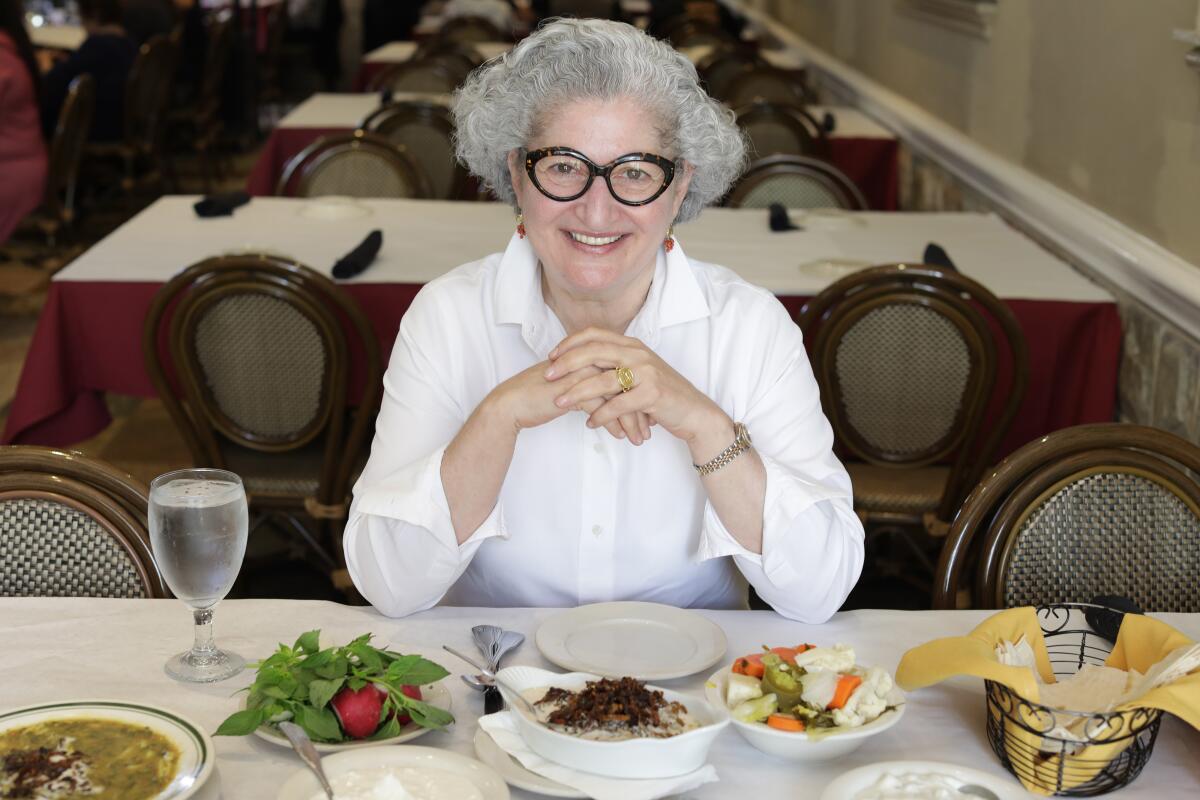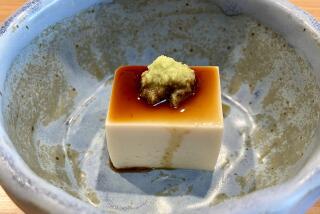This condiment is the only sauce you’ll need to hack the holidays

- Share via
- Toum, like hummus, is the Arabic name for the main ingredient and the dip.
- Zankou Chicken estimates that each year it goes through more than 1 million pounds of toum.
- Toum has become so popular that you now can find it at Trader Joe’s, Costco and Target.
The condiment shelf in my refrigerator is a chaotic place. I am no Marie Kondo, but I could argue that each jar, squeeze bottle and tube sparks real joy.
My bottle of Kewpie shares real estate with a 64-ounce jar of Best Foods. There are about eight bottles of chili crisp at any given time, plus Fly by Jing’s chili crisp vinaigrette. Fancy mustards are crowded with not-so-fancy mustards and there’s a bottle of Son fish sauce because I read that it was one of author Andrea Nguyen’s favorites. The usual suspects of ketchup, barbecue sauce and Frank’s Red Hot are all present.
The most consistent category, beyond the chili crisps, is a growing collection of toum. The garlic dip has been a favorite since I first tried garlic sauce at Zankou Chicken in Hollywood more than 30 years ago. I can still remember the sharp bite of garlic, the slight tang and the impossibly fluffy texture that seemed to disappear on my tongue.

Toum, like hummus, is the name used to refer to the ingredient and the dip. Toum means garlic in Arabic, and hummus is the word for chickpeas. Toum is a dip typically made with garlic, oil, salt and lemon, processed or pummeled until it transforms into a smooth, white paste.
Once confined to restaurants serving cuisines of the Levant, now you’ll find toum at Trader Joe’s, Costco and the refrigerator section at your local Target.
“For sure Zankou had a huge role in all the groceries and restaurants adding garlic sauce,” says Vartkes Iskenderian, whose grandparents founded Zankou in 1962 with a tiny storefront in Lebanon. “How much of a role we’ll never know, but I know when we did it, nobody knew what toum was.”
Restaurant critic Bill Addison and columnist Jenn Harris rank the 101 best restaurants in Los Angeles.
The Iskenderians started selling raw and rotisserie chickens out of a small deli in a town called Bourj Hammoud. At some point, though Iskenderian can’t recall exactly when, his grandmother Markrid started making and selling toum along with the chickens.
“The garlic, the chicken, everything was cleaned and done in our home kitchen upstairs from the shop,” Iskenderian says. “When they started serving the chicken and garlic sauce together, it was a huge hit. If you ask people in that neighborhood today where the Zankou was, they can still tell you.”

Over the last 40 years, the dip has become synonymous with the Zankou Chicken name. Iskenderian estimates that the 13 locations in Southern California go through more than 1 million pounds of the sauce in a year. The recipe is the same one Markrid made in her home in Lebanon, now prepared at a 16,000-square-foot kitchen facility in Vernon.
Each batch starts with cloves of garlic from Christopher Ranch in Gilroy. There are seven full-time team members who inspect each clove of garlic for blemishes, then trim or discard as needed. The facility goes through more than 400,000 pounds of garlic a year.
Iskenderian is tight-lipped about the ingredients but says there are laughably few in the recipe. It’s all run through a food processor and transported in large tubs via refrigerated trucks to the various locations.
Though Zankou Chicken contributed to the proliferation of toum in Southern California during the 1980s and ’90s, the dip can be found all over the Levant.
“It’s very difficult to pinpoint the origin of dishes in the Levant given that it was once part of the Ottoman Empire,” says chef and author Anissa Helou, who specializes in foods of the region. “What is for sure is that it’s more ubiquitous in Lebanon.”
Anissa Helou hits a milestone birthday, plus our best stories of the week.
It’s typically served with shish tawook (grilled chicken), chicken wings and chicken shawarma. At restaurants in the mountains of Lebanon, Helou says it’s common to find a dish of tomato adorned with sumac and toum. And on the streets of Tripoli in the north, there are spicy fish sandwiches served on pita bread smeared with toum.
Helou’s Lebanese mother, 92, still makes toum by hand using a wooden mortar and pestle dedicated for this specific task.
“It’s basically garlic, salt, olive or vegetable oil and citric acid in restaurants and lemon juice in homes,” she says. “It takes an enormous amount of oil to get that fluffy consistency. The garlic paste emulsifies with the oil to become the dip the whole world loves.”

At Kismet Rotisserie, Sara Kramer and Sarah Hymanson’s rotisserie chicken restaurants in Los Angeles, each order of chicken is served with garlic sauce. Along with a few containers from Zankou, I usually have a side or two of the Kismet toum in the fridge. Every time I visit the restaurant, I order a handful of sides to go.
The Kismet version is lighter and looser than what you’ll find at the grocery store or Zankou, with a consistency that’s more of a puree than a paste. The garlic punch is rounded rather than sharp, and there’s a nice hit of citrus.
“It’s shocking how much people like it,” Kramer says. “Historically there has been an aversion to strong garlic, but people actually love it.”
The chefs blanch half the garlic in their recipe (shared in their new cookbook) for a few minutes before adding it to a blender with raw garlic cloves, salt, lemon juice, oil and instant mashed potatoes. Cooking the garlic helps mellow its bite, while the potatoes act as a stabilizer for the emulsification.

Kramer suggests using toum in a soup, a pot of lentils, beans, rice or anything that could benefit from a boost of garlic. It’s the ideal dipping sauce for the restaurant’s excellent crispy, schmaltzy potatoes.
Toum is a year-round fixture at my house, but the quantity seems to triple during the holidays. It’s the condiment that enhances any meat or bowl of bland mashed potatoes on the table (I type this without a specific family member’s mashed potatoes in mind, of course).
For year’s, it’s been a part of Times restaurant critic Bill Addison’s Thanksgiving tradition. Each year, he and friends who are like family to him prepare a turkey in the style of shawarma djej (chicken).
“My best friend is Lebanese,” says Addison. “For the bird’s marinade we go heavy on the lemon and garlic and a mix of seasonings inspired by baharat, or Lebanese seven spices, which includes cumin, cinnamon and lots of black pepper. Sometimes we make both toum and gravy. We might skip the gravy, but never the toum.”
Beyond the holiday table, I find myself adding it to fried rice, noodles and roasted vegetables. It’s my favorite thing to spread on bread, any sandwich or burger.
“It makes you kind of a social leper after you eat it,” Helou says with a laugh. “You can’t eat toum every day if you’re seeing people because your breath will be disgusting.”
Ah, maybe that’s why I’m still single.
More to Read
Eat your way across L.A.
Get our weekly Tasting Notes newsletter for reviews, news and more.
You may occasionally receive promotional content from the Los Angeles Times.










